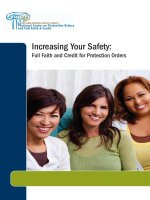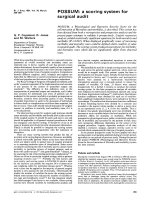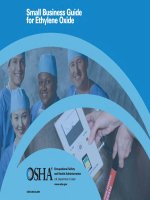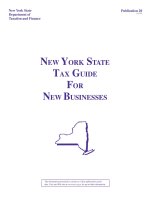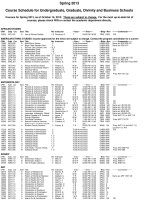Safer car 2013 insurance institute for highway safety docx
Bạn đang xem bản rút gọn của tài liệu. Xem và tải ngay bản đầy đủ của tài liệu tại đây (281.18 KB, 8 trang )
safer
car
2013
insurance institute
for highway safety
Shopping for a
Selecting a safer new vehicle is a lot easier
than it used to be. Most new cars, minivans,
pickup trucks and SUVs earn good ratings in
front and side crash tests conducted by the
Insurance Institute for Highway Safety (IIHS)
and the National Highway Traffic Safety Ad-
ministration (NHTSA). Some models still need
improvement when it comes to protecting
people in rollovers and rear crashes. So how
is a safety-conscious buyer to choose? This
publication and the vehicle ratings at iihs.org
can help you identify the best picks.
Whether you are in the market for a new or used
vehicle, here are some things to consider:
Vehicle size and weight matter. Smaller, lighter
vehicles generally offer less protection than
larger, heavier ones. There is less structure to
absorb crash energy, so deaths and injuries
are more likely. People in lighter vehicles also
experience higher crash forces when struck
by heavier vehicles. If safety is a major consid-
eration, pass up very small, light vehicles.
A crashworthy design reduces death and
injury risk. Structure and restraints help deter-
mine crashworthiness. Good structure means
a strong occupant compartment, crumple
zones to absorb the force of a serious crash,
side structure to manage the force of a strik-
ing vehicle or struck object and a strong roof
that won’t collapse in a rollover. Safety belts
keep people in their seats and spread crash
forces across the upper body’s stronger bony
parts. Airbags protect people from hitting
things inside the vehicle or objects outside it.
iihs.org/ratings
VEHICLE RATINGS
and CRASH TESTS
A good place to start is with vehicle ratings at iihs.org.
Each year, IIHS rates new models for safety based
on how well they protect people in front, side,
rollover and rear crashes. Models with good ratings
in the moderate overlap frontal test, side impact,
rollover and rear tests earn TOP SAFETY PICK.
Models that also earn good or
acceptable in a new frontal crash
evaluation called a small overlap
test earn TOP SAFETY PICK
+
. The
test replicates what happens when
only the front corner of a vehicle
collides with another vehicle or an
object such as a tree or a pole. IIHS added the
small overlap test to help drive further improve-
ments in frontal crashworthiness.
Only a few 2013 models evaluated so far qualify
for TOP SAFETY PICK+. Choose one of these if
you are looking for a vehicle that has achieved the
highest all-around safety marks.
Look for vehicles that earn IIHS TOP SAFETY PICK
+
or
TOP SAFETY PICK at iihs.org/ratings, plus at least 4 of
5 stars from NHTSA at safercar.gov.
Crash avoidance
technologies
Protecting people in crashes is vital. Avoiding
them altogether is ideal. Crash avoidance systems
can help. Many automakers offer them on 2013
models. Although relatively new, two features —
forward collision avoidance and adaptive head-
lights — already are reducing crashes, based on
analysis of insurance losses by the Highway Loss
Data Institute (HLDI), an affiliate of IIHS.
Forward collision avoidance alerts you if you
get too close to a car in front. Some systems can
brake if you don’t respond in time. Others brake
without warning you first and are meant for low-
speed traffic. Adaptive headlights shift direction
as you steer to help you see better on curves in
the dark. Lane departure warning and blind spot
detection are two other technologies intended to
help drivers avoid crashes. So far, IIHS and HLDI
haven’t been able to quantify
their benefits.
Go to iihs.org/crash_avoidance to find vehicles
with crash avoidance features.
NHTSA also identifies models with advanced fea-
tures such as lane departure warning and forward
collision warning. Go to safercar.gov to learn more.
IIHS ratings are easily accessed on the go at
m.iihs.org, our mobile site. Watch our crash
test videos at YouTube.com/iihs.
Buying a
used vehicle
IIHS has been awarding TOP SAFETY PICK since
2006, and lists of prior years’ winners are available
on our website. Here are some things to help you
assess the crashworthiness of older models:
Frontal crashworthiness — Look for good
ratings in frontal tests. Most newer models
earn top marks for frontal crashworthiness
in NHTSA’s 35 mph test head on into a rigid
barrier and the IIHS 40 mph moderate overlap
test into a deformable barrier. Drivers of
vehicles rated good are about 46 percent less
likely to die in a serious frontal crash than
drivers in poor-rated vehicles.
Side crashworthiness — Choose a vehicle
with good side ratings plus side airbags
that protect your head. IIHS and NHTSA rate
models based on tests that simulate front-into-
side crashes. The tests represent different
side impact dangers. Shoppers wanting the
best protection should look for vehicles with
the highest ratings in all conditions. Drivers
of vehicles with good ratings in the IIHS side
barrier test are 70 percent less likely to die
in a driver-side crash compared with drivers
in vehicles rated poor. Likewise, studies of
real-world crashes indicate that side airbags
substantially reduce fatality risk. Some side
airbags also are designed to protect you in a
rollover. The majority of 2008 and later models
have side airbags as standard equipment.
Roof strength — Look for a strong roof.
IIHS rates roof strength to help consumers
pick vehicles with roofs that will hold up in a
rollover crash. Stronger roofs crush less. Rat-
ings begin with 2008-09 models.
Head restraints — Pick a model with a
good seat/head restraint rating to reduce
whiplash injuries in a rear-end collision. Ve-
hicles with seat/head restraint combinations
rated good by IIHS have 15 percent fewer in-
surance claims for neck injuries than vehicles
with poor ratings. You can help increase pro-
tection by remembering to adjust the head
restraint to correctly fit behind your head.
Electronic stability control – Buy a vehicle
with ESC, standard on 2012 and later mod-
els. ESC is an extension of antilock brake
technology that helps drivers maintain control
on curves and slippery roads. ESC engages
automatically to help keep the vehicle in the
intended line of travel. It lowers the risk of a
fatal single-vehicle crash by about half and the
risk of a fatal rollover by up to 80 percent.
Go to iihs.org/ratings to see what models
have side airbags and ESC and to look up
front, side, rollover and rear crash ratings.
MeMber groups
Acceptance Insurance
ACE Private Risk Services
Affirmative Insurance
Agency Insurance Company of Maryland
Alfa Alliance Insurance Corporation
Alfa Insurance
Allstate Insurance Group
American Family Mutual Insurance
American National Family of Companies
Ameriprise Auto & Home
Amica Mutual Insurance Company
ARI Insurance Companies
Auto Club Enterprises
Auto Club Group
Auto-Owners Insurance
Bankers Insurance Group
Bituminous Insurance Companies
California Casualty Group
California State Auto Group
Capital Insurance Group
Chubb & Son
Colorado Farm Bureau Mutual Insurance Company
Commonwealth Mutual Insurance Company of America
Concord Group Insurance Companies
Cotton States Insurance
COUNTRY Financial
Dallas National Insurance Company
Direct General Corporation
Driver’s Insurance Group
Erie Insurance Group
Esurance
Farm Bureau Financial Services
Farm Bureau Insurance of Michigan
Farm Bureau Mutual Insurance Company of Idaho
Farmers Insurance Group of Companies
Farmers Mutual Hail Insurance Company of Iowa
Farmers Mutual of Nebraska
Fireman’s Fund Insurance Company
Florida Farm Bureau Insurance Companies
Frankenmuth Insurance
Gainsco Insurance
GEICO Group
Georgia Farm Bureau Mutual Insurance Company
Goodville Mutual Casualty Company
Grange Insurance
Hallmark Insurance Company
Hanover Insurance Group
The Hartford
Haulers Insurance Company, Inc.
Horace Mann Insurance Companies
ICW Group
Imperial Fire & Casualty Insurance Company
Indiana Farmers Mutual Insurance Company
Infinity Property & Casualty
Kemper Preferred
Kentucky Farm Bureau Insurance
Liberty Mutual Insurance Company
Louisiana Farm Bureau Mutual Insurance Company
Maryland Automobile Insurance Fund
Mercury Insurance Group
MetLife Auto & Home
MiddleOak
Mississippi Farm Bureau Casualty Insurance Company
MMG Insurance
Mutual of Enumclaw Insurance Company
Nationwide
New Jersey Manufacturers Insurance Group
Nodak Mutual Insurance Company
Norfolk & Dedham Group
North Carolina Farm Bureau Mutual Insurance Company
Northern Neck Insurance Company
Old American County Mutual Fire Insurance
Old American Indemnity Company
Oregon Mutual Insurance
Pekin Insurance
PEMCO Insurance
Plymouth Rock Assurance
Progressive Corporation
The Responsive Auto Insurance Company
Rockingham Group
Safeco Insurance
Samsung Fire & Marine Insurance Company
SECURA Insurance
Sentry Insurance
Shelter Insurance
Sompo Japan Insurance Company of America
South Carolina Farm Bureau Mutual Insurance Company
Southern Farm Bureau Casualty Insurance Company
State Auto Insurance Companies
State Farm
Tennessee Farmers Mutual Insurance Company
Texas Farm Bureau Insurance Companies
Tower Group Companies
The Travelers Companies
United Educators
USAA
Utica National Insurance Group
Virginia Farm Bureau Mutual Insurance
West Bend Mutual Insurance Company
Zurich North America
Funding associations
American Insurance Association
National Association of Mutual Insurance Companies
Property Casualty Insurers Association of America
January 2013
iihs.org/rss
iihs.org
m.iihs.org
youtube.com/iihs
@IIHS_autosafety
1005 N Glebe Road
Arlington, VA 22201 USA
IIHS 703/247-1500
HLDI 703/247-1600


